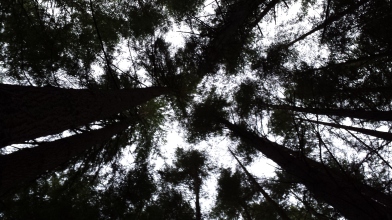Last summer I went to Iona, tramping around for the day trying to see it through Aldred’s eyes. And even though it was great to see the stone crosses, experience worship in the church, and survey the sweeping landscape, a day was not enough to really feel the place. I want to go back for a week.
Instead I came to a week long writing workshop retreat on Whidbey Island in Washington.
Crossing on the ferry reminded me of the ferry to Mull and then Iona. Only then did I think that perhaps this week might become a second Iona. The landscape is not all that different, although the latitude is less northerly. The weather was cold–and making the experience more authentic, a wind storm knocked the power out for more than three days.
While I did get a lot of good writing time and excellent feedback on Aldred’s novel, I also wrote some brief poems reflecting on the landscape, offered here in lieu of a post on Iona.
Awe
When you look up
Your head thrown all the way back
Your mouth opens

And I Begin to Sway
If you stand still long enough
You see the trees move

Path Blocked to the Sanctuary

Sometimes they break
the wind snapping, wrenching
whole branches, trunks even
Dare I touch the wounded wood?

***
On the path of the labyrinth,
though,
I could pick up the branches
and throw them out of the circle.

Sound
I can hear water,
I think,
beneath the sound of the generator.
Maybe a stream,
but I cannot see it down among the bushy woods
below me.
Or maybe it is just
the mist of rain prickling on my hood.

I love the idea of Iona through Aldred’s eyes. Was he there on a mission, helping to re-establish the community? I wonder if he met up with Amlaib Cuaran, former King of Northumbria, who retired there in 980. Imagine the conversation; two old men reminiscing!
By: Seumas MacRath on November 23, 2015
at 3:38 am
Great idea, Seumas. I have a somewhat complicated chapter on Aldred reading Boethius twice, once in Old English at the Battle of Brunanburh, and then in Latin at the end of his life. I think I need to divide it, so I could move the second reading to Iona circa 980 and have him converse with Amlaib Cuaran.
By: kljolly on November 25, 2015
at 11:43 am
The Consolation of Philosophy would certainly be appropriate reading for Amlaib in his forced retirement after losing Dublin to his stepson, Mael Sechnaill. I imagine he would empathize with Boethius’s predicament. However, he would probably need Aldred’s help in understanding the text.
Only a 12th century copy of ‘De Consolatione Philosophiae’ survives with glosses in Gaelic, although the vast majority are in Latin. Some of these glosses are inherited from an earlier exemplar; I wonder if Aldred had anything to do with that.
By: Seumas MacRath on November 30, 2015
at 3:43 am
Thanks, Seumas. Now I need to figure out how to get Aldred to Iona–retirement?
By: kljolly on November 30, 2015
at 11:43 am
If not on a mission, could he be on a pilgrimage, retracing St. Cuthbert’s path through life? According to the 15th century Northumbrian poem based on the ‘Libellus de Ortu Sancti Cuthberti’:
• Soon after the child with his dame (mother)
• Went to an isle, Hii (Iona) the name.
• In that place dwelt Cuthbert
• With religious men a start (short time).
Unfortunately, the late mediaeval doggerel is not quite up to the standard of your poetry.
By: Seumas MacRath on December 1, 2015
at 3:43 am
I am leaning toward retirement, or at least a late-in-life retreat, but the idea of a pilgrimage along St. Cuthbert’s path would be a neat way to end the novel since it starts with Cuthbert’s journey from Lindisfarne to Chester-le-Street.
By: kljolly on December 1, 2015
at 9:27 am
By Cuthbert’s journey, do you mean the years of wandering with his remains?
By: Seumas MacRath on December 2, 2015
at 4:07 am
Yes, should have clarified that, Cuthbert’s body’s journey from Lindisfarne to Chester-le-Street. The sites on the modern pilgrimage seem to be a mix of that journey, places Cuthbert supposedly visited while alive, and a few others claiming a connection of some kind.
By: kljolly on December 2, 2015
at 10:58 am
Was Amlaib/Anlaf/Olafr Cuaran documented at Brunanburh?
By: kljolly on December 1, 2015
at 9:31 am
In his ‘Gesta Regum Anglorum’ William of Malmesbury has the young Anlaf Sihticson (Analafus filius Sihctrici) fleeing Northumbria for Ireland on Aethelstan’s takeover in 927. This has led some to identify him as the same Anlaf of Ireland who returned to fight against Aethelstan in 938 (late 937?), c.f.:
https://archive.org/stream/willelmimalmesb00unkngoog#page/n249/mode/2up
Otherwise, I know of no record of Amlaib Cuaran (aka Sihtricson) before the early 940s.
There seems to be a general consensus that the Brunanburh Anlaf was Amlaib mac Gofraid (aka Olaf Guthfrithson).
By: Seumas MacRath on December 2, 2015
at 4:13 am
Thanks, that was my sense from looking at the sources in Livingston’s casebook. I can still have Amlaib Cuaran talk with Aldred about the battle–perhaps he was there or not there for some reason I can invent. Same issue with Oswulf earl of Northumbria–where was he?
By: kljolly on December 2, 2015
at 10:55 am
Yes, he is even more elusive; all we have for the 930s is conjecture. This allows you to give free rein to your imagination in both cases.
By: Seumas MacRath on December 3, 2015
at 4:06 am
[…] at St. John’s in Minnesota, who gave me the water bottle at a writing workshop last fall on Whidbey Island. Your name is on it. I pray no one blames you for my […]
By: Holy Island | Revealing Words on July 2, 2016
at 12:50 am